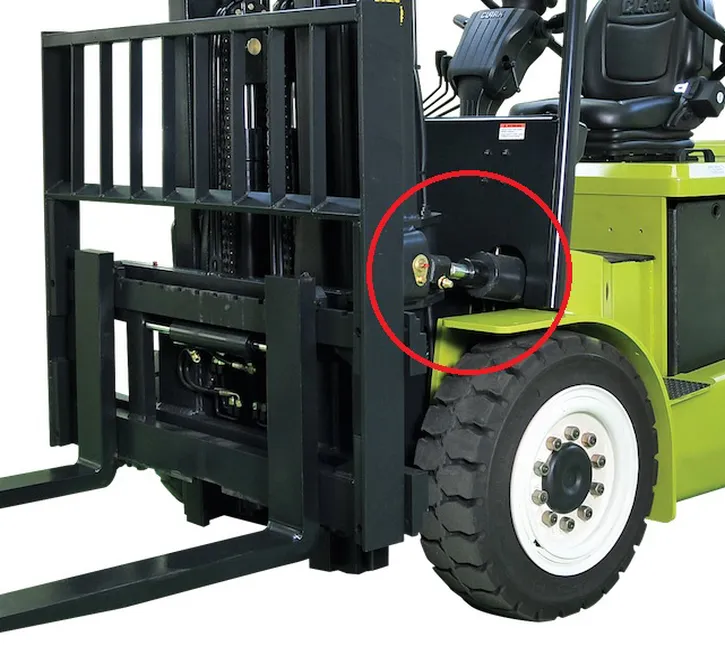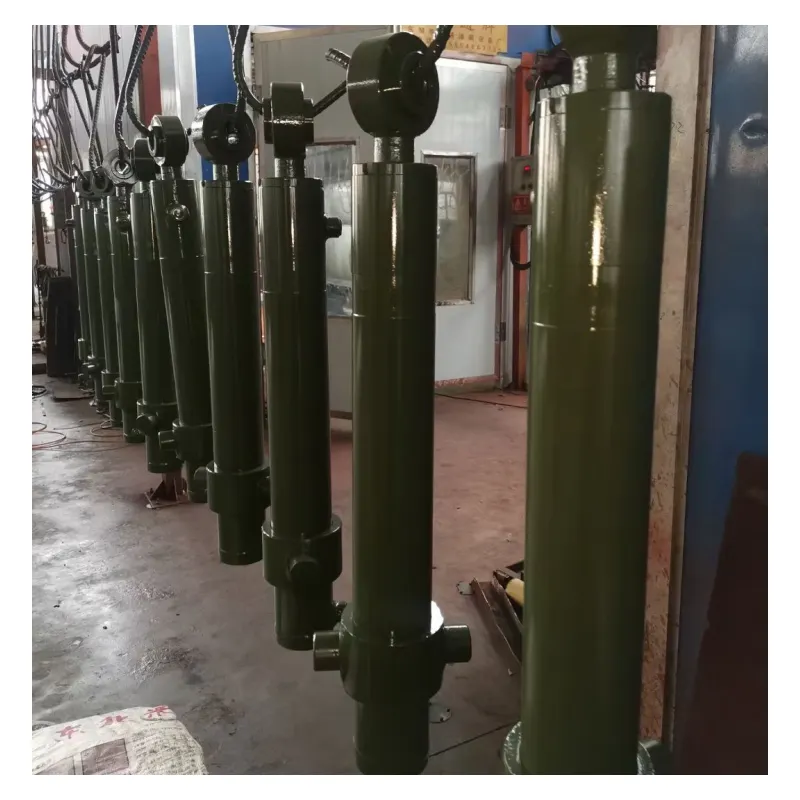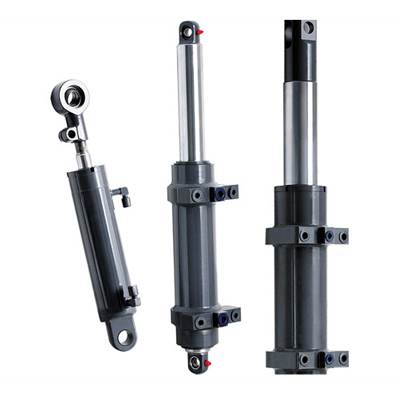Product Description
10.5MPa 15kg Double Acting Hydraulic Forklift Steering Cylinder Replacement of Toyata
The forklift steering cylinder is a hydraulic component responsible for controlling the movement of the steering mechanism on a forklift. It enables the operator to steer the forklift by transmitting hydraulic force to the wheels, allowing them to turn in the desired direction. It's important to note that the design and configuration of the forklift steering cylinder can vary among different forklift models and manufacturers. Therefore, it is recommended to consult the specific forklift's manual or the manufacturer's guidelines for accurate information regarding the steering cylinder and its maintenance procedures.
| bore diameter (D) | rod diameter (d) | stroke (S) | Installation distance (L) | working pressure | Interface dimensions (M) | weight |
| Φ65 | Φ40 | 2*98 | 672 | 10.5MPa | 2-G1/4 | 15kg |
(1) Our company can customize non-standard oil cylinders within the range of cylinder diameter D360MM and stroke L6000MM according to customer requirements;
(2) The above product prices are nontax unit prices, excluding packaging and transportation costs required for the export
Here are some critical applications of the forklift right lifting cylinder:
1. Function: The steering cylinder converts hydraulic pressure into linear motion, which is used to actuate the steering mechanism. When the operator turns the steering wheel or operates the steering control, hydraulic fluid is directed to the steering cylinder, causing the piston rod to extend or retract. This movement is transmitted to the steering mechanism and ultimately results in the turning of the forklift's wheels.
2. Structure: The steering cylinder typically consists of a cylinder barrel, piston rod, seals, and hydraulic connections. The cylinder barrel houses the piston attached to the piston rod. The seals ensure proper sealing and prevent hydraulic fluid leakage. The cylinder is mounted to the forklift's chassis, and the piston rod is connected to the steering linkage or mechanism.
3. Hydraulic System: The forklift steering cylinder is an integral part of the forklift's hydraulic system. It receives hydraulic fluid from the hydraulic pump, which the operator controls through the steering input. The hydraulic fluid is directed to the steering cylinder via valves and hoses, allowing for the desired steering motion.
4. Steering Control: The forklift steering cylinder is operated by the steering control inputs provided by the operator. This can be in the form of a steering wheel, joystick, or other steering control mechanisms. As the operator turns the steering control, it activates the hydraulic system, which causes the steering cylinder to extend or retract, resulting in the desired steering action.
5. Maintenance: Proper forklift steering cylinder maintenance is crucial for optimal performance. Regular inspections should be conducted to check for any signs of fluid leakage, damaged seals, or misalignment. The hydraulic fluid level and quality should be monitored and maintained according to the manufacturer's recommendations. Any issues or abnormalities should be addressed promptly to ensure safe and efficient steering operation.
The working principle of forklift steel cylinder
-
Hydraulic System: The forklift's hydraulic system consists of a pump, hydraulic fluid, valves, hoses, and the hydraulic cylinder. The hydraulic pump pressurizes the hydraulic fluid, which is then directed to the hydraulic cylinder through control valves and hoses.
-
Cylinder Structure: The hydraulic cylinder consists of a cylindrical barrel, a piston, a piston rod, and seals. The barrel is a steel tube with precision-machined internal surfaces. The piston is a cylindrical component that fits inside the barrel and divides it into 2 chambers. The piston rod extends from the piston and is connected to the lifting mechanism, such as the forks or mast.
-
Working Principle: When the operator activates the lift control lever or joystick, hydraulic fluid is directed to the hydraulic cylinder. The pressurized fluid enters 1 side of the cylinder, causing the piston to move. As the piston moves, it pushes the rod, translating the linear motion into a lifting force. The forklift's load is attached to the lifting mechanism, and the hydraulic cylinder exerts the power necessary to raise or lower the burden.
-
Seals and Fluid Control: The hydraulic cylinder incorporates seals to prevent hydraulic fluid leakage between the piston and the barrel. These seals ensure efficient operation and maintain the pressure required for proper lifting. The control valves in the hydraulic system regulate the flow of hydraulic fluid into and out of the cylinder, enabling precise control of the lifting and lowering functions.
-
Load Holding: Once the desired height is reached, the hydraulic cylinder can hold the load in position. The hydraulic system maintains pressure in the cylinder, locking the piston and preventing unintended bag lowering.
Our Company
We have a first-class independent R&D platform for assembly. The forklift cylinder production workshop has 4 semi-automatic lifting cylinder assembly lines and 1 fully automatic tilting cylinder assembly line, with a designed annual production capacity of 1 million pieces; the special cylinder workshop is equipped with semi-automatic cleaning and assembly systems of various specifications, with a designed annual production capacity of 200,000 essays. It has famous CNC machining equipment, machining centers, special equipment for high-precision cylinder processing, robot welding machines, automatic cleaning machines, automatic cylinder assembly machines, and automatic paint production lines. We have more than 300 sets of critical equipment running. The optimized allocation and efficient utilization of equipment resources ensure the precision requirements of the products and meet the high standard quality requirements of the products.
|
Forklift cylinder assembly shop |
Other types of cylinder assembly shop |
Welding
Painting & coating
|
Painting & coating line |
Fully automatic water-based |
Testing
To further improve product performance, and establish the leadership position of our hydraulic cylinder in the industry, our company and zjimee jointly established a Comprehensive performance laboratory of hydraulic cylinders, hydraulic valves, and hydraulic pumps; the lab is computer-assisted testing, using electro-hydraulic control technology, the test conditions preset by computer, which improves the test accuracy and system versatility, and the experimental data.
The automatic collection is realized through the application of sensors, and the output data, such as the internal leakage and load efficiency of the cylinder or the valve, are directly processed by the computer and converted to standard units (ml/min; %). At the same time, to ensure the working safety of the hydraulic system, the state monitoring function is carried out for key performance parameters, such as "oil temperature monitoring, liquid level monitoring, filter device monitoring," etc. Among them, the hydraulic cylinder test stand can test the performance of "load efficiency" and "internal leakage" by readings. At the same time, it is equipped with a grating ruler measuring instrument, which meets the requirements of all test items of hydraulic cylinder products in the national standard.
Our Factory
Packaging & Shipping
/* March 10, 2571 17:59:20 */!function(){function s(e,r){var a,o={};try{e&&e.split(",").forEach(function(e,t){e&&(a=e.match(/(.*?):(.*)$/))&&1
| Certification: | GS, RoHS, CE, ISO9001 |
|---|---|
| Pressure: | Medium Pressure |
| Work Temperature: | Normal Temperature |
| Acting Way: | Double Acting |
| Working Method: | Rotary |
| Adjusted Form: | Regulated Type |

How does a forklift hydraulic cylinder contribute to quick load release?
A forklift hydraulic cylinder plays a crucial role in facilitating quick load release during material handling operations. Here's an explanation of how it achieves this:
The hydraulic cylinder's contribution to quick load release is primarily attributed to its design and the following factors:
1. Cylinder Actuation:
The hydraulic cylinder is actuated by the controlled release of hydraulic fluid. When the operator activates the appropriate controls, the hydraulic system allows the fluid to flow back into the reservoir, causing the cylinder to retract rapidly. This rapid retraction enables quick release of the load, expediting the unloading process.
2. Flow Control Valves:
The forklift's hydraulic system incorporates flow control valves that regulate the rate of fluid flow to and from the hydraulic cylinder. During load release, these valves can be adjusted to increase the flow rate, allowing the hydraulic fluid to return to the reservoir more quickly. By controlling the flow, the cylinder can retract rapidly, facilitating quick load release.
3. Load Lowering Speed:
Hydraulic cylinders also contribute to quick load release through their load lowering functionality. When the operator desires to lower the load rapidly, the hydraulic system can be adjusted to increase the flow rate of the hydraulic fluid, which allows for faster descent of the load. This controlled acceleration of load lowering speed helps expedite the unloading process.
4. Responsive Control System:
The forklift's hydraulic control system, including the controls for the hydraulic cylinder, is designed to be responsive and easy to operate. The operator can quickly activate the load release functions, initiating the rapid retraction of the cylinder and the subsequent quick release of the load. The intuitive control system ensures efficient and timely load release.
5. Safety Measures:
While facilitating quick load release, forklift hydraulic cylinders also incorporate safety measures to prevent uncontrolled or accidental release of the load. These safety features, such as pressure relief valves and load holding valves, ensure that the load release process remains safe and controlled, minimizing the risk of accidents or damage.
In summary, a forklift hydraulic cylinder contributes to quick load release through its actuation mechanism, flow control valves, load lowering functionality, responsive control system, and integrated safety measures. By utilizing these features, the cylinder enables rapid retraction and controlled release of the load, enhancing the efficiency of material handling operations.

Can hydraulic cylinders be used in container handling forklifts?
Yes, hydraulic cylinders are commonly used in container handling forklifts. Container handling forklifts, also known as container handlers or reach stackers, are specifically designed for lifting and moving shipping containers. Hydraulic cylinders play a crucial role in the operation of these specialized forklifts. Here's an explanation of how hydraulic cylinders are used in container handling forklifts:
Hydraulic cylinders are utilized in container handling forklifts in the following ways:
1. Mast Lifting:
The main function of hydraulic cylinders in container handling forklifts is to lift and lower the mast. The mast is the vertical assembly that houses the lifting mechanism and forks. Hydraulic cylinders, typically positioned on either side of the mast, provide the power and control for vertical movement. By extending or retracting the cylinders, the forklift can lift and lower containers to the desired height, allowing for stacking or unstacking operations.
2. Reach and Extend:
Container handling forklifts often feature telescopic masts that can reach out and extend. Hydraulic cylinders are responsible for extending and retracting the telescopic sections of the mast. These cylinders enable the forklift to reach containers that are placed further away or to adjust the reach based on container size. The precise control offered by the hydraulic cylinders allows for accurate positioning and safe handling of containers.
3. Container Tilting:
In some container handling forklifts, hydraulic cylinders are used to tilt the container. Tipping containers slightly can help with load stability during stacking or unstacking. Hydraulic cylinders control the tilting operation, allowing the forklift operator to adjust the container's angle as needed.
4. Side Shift:
Container handlers often feature side shift functionality, which allows the forks or attachment to move horizontally. Hydraulic cylinders are employed to control the side shift movement, enabling precise positioning of the forks or attachment when handling containers. This feature facilitates alignment with container corners and ensures secure engagement.
5. Attachment Control:
Container handling forklifts may have specialized attachments, such as container spreaders or twist locks, for secure container lifting and transport. Hydraulic cylinders play a vital role in controlling the movements of these attachments. They enable precise adjustments and alignment, ensuring proper engagement with the container and safe handling during loading and unloading operations.
In summary, hydraulic cylinders are extensively used in container handling forklifts for mast lifting, reach and extend operations, container tilting, side shift functionality, and attachment control. These cylinders provide the necessary power, control, and precision required to handle containers efficiently and safely in various container terminal and port environments.

How does a forklift hydraulic cylinder assist in lifting loads?
A forklift hydraulic cylinder plays a critical role in assisting the lifting of loads. Here's a detailed explanation of how it works:
When a forklift needs to lift a load, the hydraulic cylinder generates the necessary force to raise the load to the desired height. Here's a step-by-step process of how the hydraulic cylinder assists in lifting loads:
1. Hydraulic Pressure:
When the operator activates the hydraulic controls of the forklift, hydraulic pressure is generated in the hydraulic system. This pressure is typically created by a hydraulic pump, which pressurizes the hydraulic fluid (usually oil) in the system.
2. Hydraulic Fluid Flow:
The pressurized hydraulic fluid is directed to the hydraulic cylinder through control valves and hoses. The fluid enters the cylinder through the inlet port, filling one side of the cylinder.
3. Piston and Piston Rod Extension:
As the pressurized hydraulic fluid enters the cylinder, it acts on one side of the piston. The force exerted by the fluid pushes the piston and the connected piston rod upward.
4. Load Lifting:
As the piston rod extends, it transfers the force to the load-bearing structure of the forklift, such as the mast assembly. The force exerted by the hydraulic cylinder enables the forklift to lift the load off the ground.
5. Load Stability:
The hydraulic cylinder assists in maintaining load stability during the lifting process. The controlled extension of the cylinder allows for smooth and precise lifting, reducing the chances of load tilting or instability.
6. Load Holding:
Once the load reaches the desired height, the hydraulic system can hold the load in place using a valve or a locking mechanism. This ensures that the load remains securely lifted until the operator decides to lower it.
The hydraulic cylinder's ability to generate a significant amount of force allows forklifts to lift heavy loads efficiently. By controlling the flow of hydraulic fluid and adjusting the cylinder's extension, the operator can precisely control the lifting speed and height.
In summary, a forklift hydraulic cylinder assists in lifting loads by utilizing hydraulic pressure to extend the piston and piston rod, transferring force to the load-bearing structure of the forklift. This hydraulic force enables the forklift to lift heavy loads, and the controlled extension of the cylinder ensures load stability and precise lifting capabilities.


editor by CX 2024-02-10